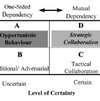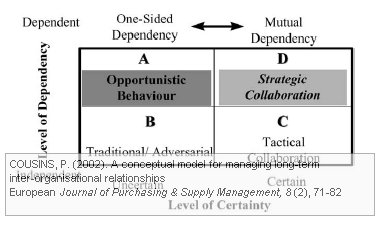 ‘All firms are snakes’. So says Paul D. Cousins in A conceptual model for managing long-term inter-organisational relationships, published in 2002. ‘They are maximisers and satisfiers concerned with their own survival and self-interest’. I find that a rather harsh statement. How is collaboration and relationship management possible in such an environment? The issue that needs to be addressed is perhaps not so much about building trust, but about optimally managing the self-interest of the involved parties. And in the end, competition is maybe better than collaboration after all…
‘All firms are snakes’. So says Paul D. Cousins in A conceptual model for managing long-term inter-organisational relationships, published in 2002. ‘They are maximisers and satisfiers concerned with their own survival and self-interest’. I find that a rather harsh statement. How is collaboration and relationship management possible in such an environment? The issue that needs to be addressed is perhaps not so much about building trust, but about optimally managing the self-interest of the involved parties. And in the end, competition is maybe better than collaboration after all…
Business relationships are not complex, they are simple
It is hard not to include this paper by Paul D. Cousins when writing about buyer-supplier relationships or collaboration between firms, simply because the strength of this paper lies in the simplicity of its conclusions. Using a game theory approach, Cousins develops a model of inter-firm relationships, based on the following key points:
- Partnerships do not exist, varying collaborative relationships do.
- Organisations do not trust each other, decisions are based on risk assessment.
- A relationship is a process, not an entity.
While I personally like to believe that this black-and-white world view on business is not the case, Cousins does make a good case for his approach.
Two strands of literature
In his literature review, Cousins identifies two strands of research:
- a behavioural approach – businesses can interact as humans do in their relations
- an economical approach – business interactions are based on economic power
These two relationship approaches seem irreconcilable in that while the latter emphasizes short-term cost reductions as the (only) means to compete and survive, the former advocates long-term partnering as the surefire way to survive in the long run.
Purchasing is now supply
Regardless of approach, in today’s interconnected and globally outsourced supply chains, business relationships are increasingly seen as a strategic matter; this has changed the role of purchasing from a pure contractual and temporal buyer-seller relationship towards that of long-term collaboration or partnering. When a company’s supply becomes strategic so, do said company’s relationships with its suppliers, and procurement needs to take on a more friendly approach than before. That poses certain challenges and hence the need for a new model for relationship management.
The new paradigm
Using a game theory approach, Cousins develops a model of inter-firm relationships, where the level of certainty versus the level of dependency determines four types of relationships:
- Independent/Uncertain – Traditional/Adversarial
- Dependent/Uncertain – Opportunistic
- Independent/Certain – Tactical Collaboration
- Dependent/Certain – Strategic Collaboration
Copyright note: The figure below is taken from the article.

Cousins defines Dependency by these terms:
- Historic – An established relationship
- Economic – One-sided, market leader or technology leader vs. the other(s)
- Technological – One-sided, technology supplied vs. technology required
- Political – Legal or political obligations to use a certain supplier
Cousins defines Certainty by these terms:
- Contractual – will either party really stick to the contract?
- Competence – does either party really have the skills or capabilities required?
- Goodwill – will either party really help each other out if necessary?
- Political – will either party fulfill internal or external issues, related and/or unrelated?
Cousins then goes on to describe business relationships that fit into these models.
A relationship is an ongoing process
In conclusion, Cousins argues that while collaborations may have their rightful place, it is more useful to think of relationships as a continuous process that moves between the four boxes in the figure above. Relationships are not static, they are dynamic, and dynamic here does not mean disbanding old relationships and forming new ones. rather does it mean to take existing relationships to other levels of dependency and certainty. As Cousins says in one of his final statements: ‘The issue is about choosing the correct relationship process to deliver the desired output.’
The snake
That said, I am somewhat puzzled by the last paragraph, in which he writes:
It must be remembered that all firms are ‘snakes’; they are maximisers and satisfiers concerned with their own survival and self-interest. If that self-interest is best served by working closely with another firm then they will do so. However, when that interest is no longer served, rest assured, they will bite you!
Two interpretations come to my mind: 1) There’s really no point in collaboration. You will lose anyway. 2) Unless a you keep your relationships under scrutiny (and change them accordingly), they may backfire before you know it. Either way, collaboration is obviously not THE way to salvation and should not (necessarily) be the first-order strategy for any business. Not according to Cousins.
Göran Svensson?
Interestingly, Göran Svensson, in his 2004 article Vulnerability in business relationships: the gap between dependence and trust, picks up a similar note, when he developed his see-saw model of dependence and trust.
Reference
COUSINS, P. (2002). A conceptual model for managing long-term inter-organisational relationships European Journal of Purchasing & Supply Management, 8 (2), 71-82 DOI: 10.1016/S0969-7012(01)00006-5
Author Link
- manchester.ac.uk: Paul D Cousins
- mbs.ac.uk: Paul D Cousins












